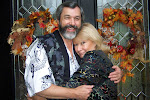
Wednesday, September 22, 2010
Sunday, September 19, 2010
Wednesday, September 8, 2010
The Real Henry VIII
Tuesday, September 7, 2010
Fire in the Sky


Fireworks are almost as old as the invention of gunpowder. From the earliest days when gunpowder was first created, its use to entertain as well as destroy has been a fact of life. Countless billions have been thrilled by the explosion of color that has lightened the night sky in celebration. From the birth of a monarch to the birth of a nation, victories, milestones and great achievements have all been given the fireworks treatment. These celebrations bring enjoyment to all when man has used fireworks to ignite the night sky.
Thursday, September 2, 2010
Lighting the city 1840's style


In the day's before electric light the cities of the world were often illuminated by gaslight. Here are two shots of the working gaslight street lights. If you look close at the close up photo you will see that the lamp lighter has forgotten to extinguish the gas when the new day began. These lights are in Old Town Alexandria, VA
Sunday, August 29, 2010
Saturday, August 28, 2010
Tuesday, August 24, 2010
Weapons of War 13th Century Style
Sunday, August 22, 2010
The Lord of the Manor will See you Now
Thursday, July 29, 2010
Art Nouveau
Tuesday, July 27, 2010
Warrior Incense Burners


This pair of Aztec warrior effigy incense burners were found at the entrance of a tomb. They are from CE 1200–1500, made of ceramic and belong to the Jay I. Kislak Collection, Rare Book and Special Collections Division, Library of Congress. Both have warrior images on the front, each with a different color kilt, one blue and one red. The warriors are armed with Atl-atl spear throwers and circular shields. The Atl-atl was a feared weapon in the hands of a skilled warrior.
Wednesday, July 14, 2010
Now That's a Helmet!
Monday, July 12, 2010
The Story of Rome
Thursday, June 10, 2010
General Victorious
Sunday, May 23, 2010
Light Cavalry of the Emperor

The light cavarly were a key part of every army o the Napoleonic Wars of the late 18th and early 19th Centuries. Their main role as scouts, flank protectors, raiders and to run down broken enemies were fullfilled by a huge amount of colorful regiments. These are the French 11th Hussars and 6th Chevau-Legers-Lanciers. In the background you see artillery support from a Wurttemberg horse artillery battery and a light infantry regiment, the 2nd Wurttemberg Jagers.
Tuesday, May 18, 2010
The Greatest Recruiting Poster Design


Most Americans instantly recognize the poster of Uncle Sam wanting you for the US Army. Few Americans realize that this poster idea was copied from the British one shown here where Field Marshal Lord Kitchener wants you to join the British Army.
Lord Kitchener was the War Secretary of Great Britain from the start of the Great War until he died when HMS Hampshire was sunk in 1916.
Monday, May 10, 2010
Imperial German High Seas Fleet




On a hazy morning, the Battle Squadrons of the German Imperial High Seas Fleet sets sail to challenge the might of the Royal Navy. Sooner or later both fleets felt the war would be decided in the greatest naval engagement in world history. Till then, German naval officers would toast "Der Tag" for the day German seapower would replace the Royal Navy as the true power of the seas. The sea battle would come in 1916 at Jutland, a tactical German victory but a stratigic British victory. The High Seas fleet would never again meet the Royal Navy in line of battle. Rather it would slowly waste a way in harbour, its finest men siphoned off to the underseas fleet. In the end the surface navy would lead the way to the revolt that forced Kaiser Wilhelm II to abdicate. After beening forced into internment at Scapa Flow in Scotland the High Seas Fleet ploted its own self destruction. In a single afternoon, under the eyes of its British guards, the majority of the fleet was scuttled by its German crews. Through its death the honor of the HighSeas Fleet was restored.
Thursday, May 6, 2010
And the Great War Began


German Jagers (Light Infantry) pass through hasty wire entanglements in the early days of the war. While French troops in the famous pantalon rouge desperatly try to hold back the German advance (and yes the officers did go into the first battles with white gloves and bright red hats). French casualties, due to a variety of factors including weapons, training and a faulty War Plan XVII, were immense. They suffered more than one million casualties in just the first three months of the war!
The Lights were Ready to go Out all over Europe
To fully understand both the causes of the Great War and what was lost, I strongly recommend that you read two works by historian Barbara Tuchman. "The Proud Tower" paints a vivid picture of the Victorian-Edwardian World of the early 20th Century. A world of hope and promise, that also held the seeds of its own destruction. "The Guns of August" is a frightening story of how plans upon plans failed and lead the world into the horrors of the Great War. If I could, I would make this book manditory reading for every world leader. Its warning is clear: beware over estimating your own power and brilliance and at your peril underestimate those of your opponents.
Friday, April 30, 2010
The Change of Powers in Europe 1871
Sunday, April 18, 2010
Home of the Rich








Just a few photos of how the rich and powerful have lived over the last centuries in the UK. The size of Kensington Palace, the Queens Buckingham Palace, fancy chimneys and stain glass windows at Hampton Court Palace, the "Circle" in Bath,a bed fit for a king-William III, Tudor Coat of Arms, and private gardens at Powis Castle.
Subscribe to:
Posts (Atom)



























